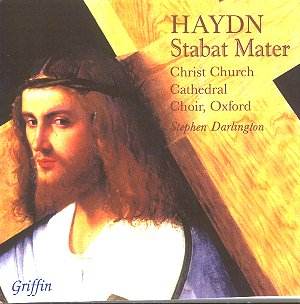 |
Franz Josef HAYDN (1732 - 1809):
Stabat Mater, Hob XXbis Jeanette Ager (mezzo) Andrew Carwood (ten); Giles Underwood (bass) David Goode (org) Choir of Christ Church Cathedral, Oxford London Musici Conducted by Stephen Darlington Recorded in April 2001 in Christ Church Cathedral, Oxford Griffin sales sales@griffinrecords.co.uk |
This is the first large-scale choral release on the small independent Griffin label. Their choice of Haydn's Stabat Mater is a felicitous one.
The work was composed in 1767, six years after Haydn had entered the service of the Esterhazy family. It thus pre-dates most of his mass settings and all his oratorios. The orchestral forces required are fairly modest with only a pair of oboes/cors anglais, a bassoon and organ in addition to the strings. As befits the subject, minor keys and moderate tempi predominate.
While the work may not possess the immediate appeal of, say, Creation, it contains much eloquent music. Certainly Haydn was inspired by the text: the notes quote his assertion that "I set to music with all my power the highly esteemed hymn, called Stabat Mater." It is music which challenges those who perform it. Happily, this challenge is met by the present artists who give a very satisfying account of the work.
The four soloists are all young British singers and all acquit themselves well. Generally they do very well in their respective solos, though I thought Andrew Carwood did not sound entirely at ease in 'Fac me crucem custodire'. They also blend well when singing together.
The 29-strong choir contributes to 6 of the 14 movements. They are well balanced and produce a good, clear and well-focused sound. The presence of boys' voices gives a pleasing degree of edge to the choral sound. The accompaniment by London Musici is alert and stylish.
Stephen Darlington, the Director of Music at Christ Church, directs the whole performance with appropriate feeling. He takes a very different view of the work as compared to Trevor Pinnock in his 1989 recording for DG Archiv. Where Pinnock is urgent and dramatic Darlington is more relaxed and flowing. Pinnock's performance is darker and more weighty (he takes nearly 9 minutes longer) and his use of period instruments results in more 'bite'. It must also be said that, good though Darlington's soloists are, Pinnock's team are even finer, Anthony Rolfe Johnson in particular.
However, it seems to me that either approach to the work is completely valid and I enjoyed the Darlington version just as much as Pinnock's. Darlington's tempi throughout are natural and fluent and he ensures the performance is full of light and shade. The text of Stabat Mater may be a sorrowful one but Haydn's setting is never maudlin or lachrymose; neither is Darlington's performance.
The engineers have produced a very natural, clear and well-balanced sound. They use very positively the acoustics of Christ Church Cathedral to obtain just the right amount of resonance and ambience.
There is one other notable contributor to the project in the shape of H. C. Robbins-Landon, the great Haydn scholar who provides a characteristically authoritative and informative note.
In summary, a most successful and enjoyable release. I hope that the fact that the disc is produced by a small label will not stop it reaching a wide audience.
John Quinn